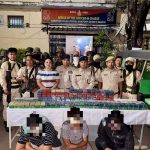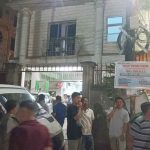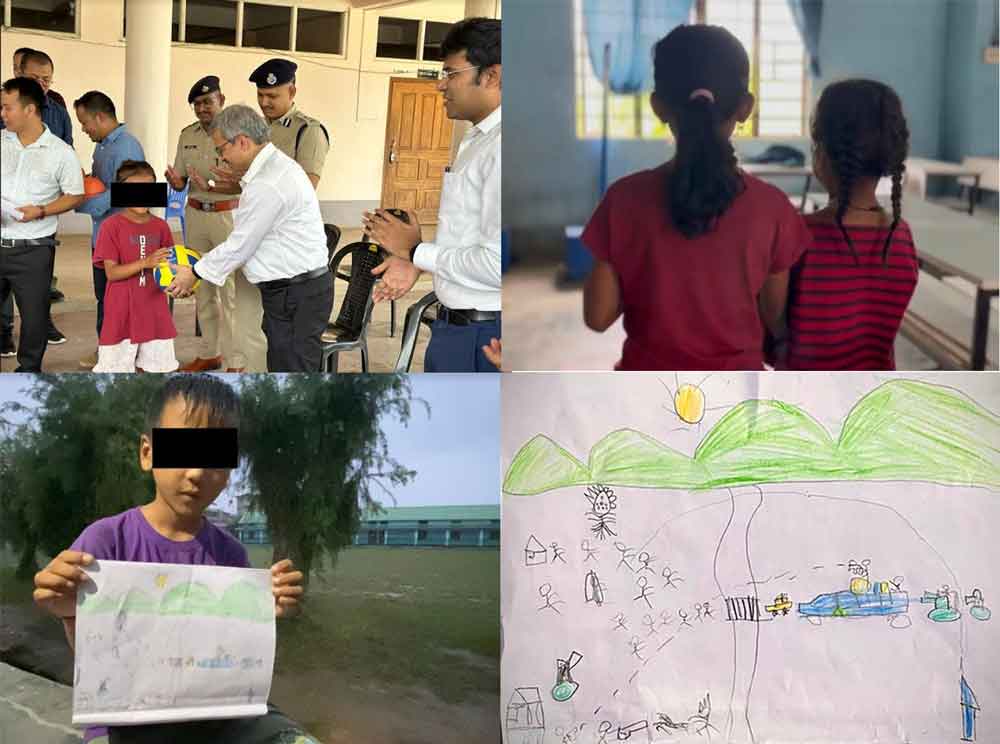Imphal (DIPR): “An unsuspecting village comes under attack. Line pencil sketch of unarmed villagers come out to thwart off the advancing armed miscreants approaching the village on armoured vehicles, each with mounted automatic weapons firing away, depicted by a series of dashes (signifying a bunch of high speed bullets flying in the air towards the opponent side). Village guards are seen putting up a fight, retaliating from the cover of a bunker. The violence is happening in the foothills of four sloping green mountains with a yellow Sun shining bright in the sky.”
This thought steering pencil sketch is the images reproduced by an 8-year-old boy, Khamba (name changed), whose house in Churachandpur was completely gutted in the arson of May 3rd. Since then, Khamba and his widowed mother had been evacuated to Imphal and compelled to live in a relief camp there. Khamba has drawn many such drawings, indicating the trauma he had experienced when his village came under attack and subsequently burnt down to ashes by armed miscreants in Churachandpur.
According to the data made available by the department of Social Welfare, government of Manipur, there are 12,694 displaced children living in relief camps across the state, and out of them, 100 are severely traumatized needing professional counselling.
“A child may not be traumatized immediately. But that trauma can come up after one week or a month. What we’ve been doing is – initially our counselors will visit the relief camps. Whenever they find such severely traumatized children, they will be identified, and taken to professional counselors. We’ve done this for little more than 100 children. We hope that this number does not increase and these traumatized children can go back to normal very soon.” – said Ngangom Uttam Singh, director, Social Welfare department, Govt of Manipur.
Towards addressing the mental health of the displaced children, counsellors are deployed through District Children Protection Offices in every district. They visit children’s homes, relief camps to give counselling and to identify children who actually require professional counselling. The department has a team of qualified medical practitioners and child psychiatrists working as volunteers who aid in providing professional counselling to those who are severely traumatised.
Child Psychiatrist Dr. Jina Heigrujam, who has visited several relief camps to identify children having PTSD or post-traumatic stress disorder explains, why professional counselling is essential to avoid a myriad of mental health issues from developing. According to Dr. Heigrujam, art and dance therapy are the best techniques that work well with children to get them out of their traumatic experience.
“If stress is prolonged and isn’t able to adjust to it, what happens is there are a myriad of mental health issues that can come out of it. Most common is post-traumatic stress disorder or depression in childhood or anxiety. In order to help them out, we’ve dived deep into the layers to understand how badly they are affected. To do this there are lots of techniques. One of them that work well with children is Art therapy” confided the child psychiatrist.
Field visits were conducted by the field functionaries of the Social Welfare department to identify stress affected children at relief camps in Wangjing, Thoubal district
Thankfully, these functionaries are trained to screen for severely traumatised children by a team of resource persons from the National Institute of Mental Health and Neuro-Sciences, NIMHANS Bangalore who visited the state.
The functionaries visiting the relief camps employ ‘play and dance’ methods to identify stress affected children. At the Lamding relief camp in Wangjing in Thoubal district where internally displaced residents of Moreh and Serou are sheltered, the specialists identified 3-year-old Yaiphaba (name changed) as a traumatized child. Unlike other children of his age and locality, Yaiphaba refused to join in the group activities. He is visibly frightened and clings to his aunt. Even luring him with toys and color pencils do not work. He tightens his hold on his aunt as if sensing danger. All this while, the other kids in the Lamding camp were dancing to a happy tune following the steps of the child specialists. Yaiphaba eases a little when his mother arrives and holds him. Gradually, he gets drawn to the general moods of fun and frolic and dancing to peppy beat. According to Yaiphaba’s mother, there was a turmoil in their house on the night of May 3rd at Moreh when 50-60 people from the locality rushed into their house to take shelter after arson struck the locality, burning selective shops and houses. The upheaval in the home affected young Yaiphaba.
“Before the incident, he wasn’t afraid of people but after the incident whenever there are gatherings of people, especially of strangers he keeps saying he is afraid. He has also become reluctant to speak out”, revealed his worried mother.
After the play and dance group exercise, the displaced children are given drawing pencils and papers and asked to sketch/draw anything they like. The room is filled with excitement as the children begin to draw their favourite things like ice candy, landscape, flowers, dolls, pets and even the national flag. Invariably, some of the drawings reflect traumatic experiences like that of Khamba of a village coming under attack by armed miscreants.
At the Lamding camp, the case of 11-year-old Tomthin, (name changed) who hails from the border town of Moreh, is unique and reveals a deep sense of anger and revenge motive. When he was asked to draw anything, he liked he sketched an armed miscreant. When asked who he was and why he (Tomthin) drew it, he said, “It is the enemy miscreant. When I’m done with it, I shall paste it on the wall and then tear it up into pieces with a pencil. When I do that, I feel relieved. I feel relieved because they burnt our house.”
After the identification exercises, visiting functionaries adopt another fun way to overcome the stress. Coincidentally, the day happened to be the 3rd birthday of Yaiphaba. So, a birthday cake was ordered. Birthday caps were distributed. The children along with the functionaries sing the happy birthday song to Yaiphaba and as if on cue, the tiny tot happily blows out the three lighted colorful candles. Then the whole group continued dancing to the beat of a popular Manipuri song – “Bullet, Bullet, Bullet, Bullet, Nongmei Bullet, Nangna Eihakki.” Even as the children are joyously dancing, pieces of the birthday cakes were distributed, Punshiba being the first to taste the cake. The fun and the frolic provided the much-needed relieved and even lifted the spirits of the children.
Another cause of concern that the Social Welfare department is looking to address is the status of the relief camps vis-à-vis their children friendliness. As the relief camps are unplanned and set up on a need basis, a UNICEF team, which visited the state, provided a blue print for setting up children friendly relief camps. The department is looking into this crucial need. Social Welfare director also added that to pluck out shortfalls in the care for the children in relief camps, review meetings are held at the Chief Secretary’s level every week. Even regarding nutrition issues of the children, the department is actively monitoring with severely malnourished children being sent to the state-run Jawaharlal Nehru Institute of Medical Sciences in Imphal where treatment is available. So far, 16 children have been treated for severely malnourished cases.
Taking into account all pre requisite aspects to address the overall woes of the tiny tots in the face of the turmoil the government has convened series of meetings.
Towards this end, Manipur Chief secretary Dr Vineet Joshi and his subordinate officials have been visiting relief camps in both the hill and valley districts to take stock of the conditions of children putting up there. As part of the campaign, he flew to Churachandpur district and spent time with kids at the camps and presenting gifts much to the delight of the children.











